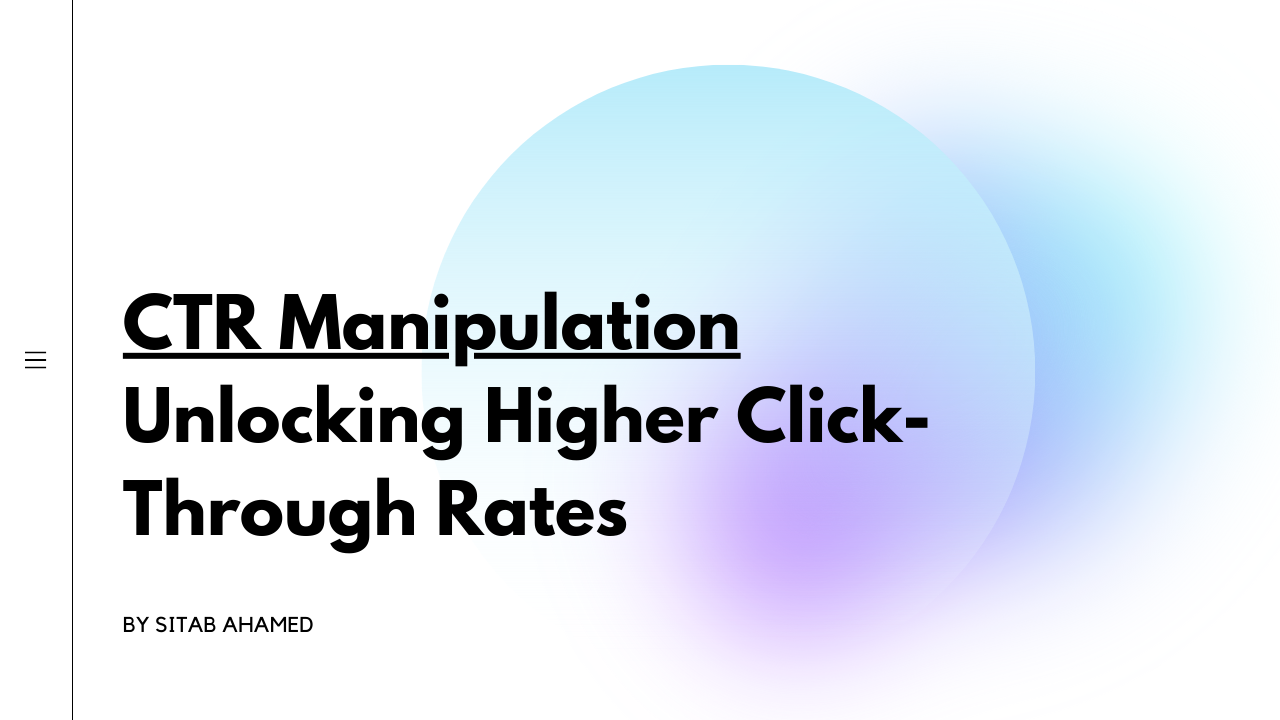Boost Your Advertising Strategy With CTR Adjustment
In today's affordable electronic landscape, maximizing Click-Through Rate (CTR) has actually emerged as a critical component of effective advertising approaches. A keen understanding of CTR not only informs content development yet also improves target market interaction and drives conversions. The real potential of CTR control expands beyond simple numbers; it forms the really essence of just how brand names connect with consumers.
Recognizing Click-Through Price

A number of aspects can influence CTR, consisting of the high quality of the material, the positioning of the web link, and the effectiveness of the call-to-action (CTA) As an example, eye-catching visuals and compelling headlines can dramatically improve the probability of individuals clicking with. Additionally, comprehending the audience's preferences and habits can aid customize web content that motivates communication.
Marketing professionals make use of CTR not just to determine the success of individual campaigns but likewise to benchmark performance against market standards. Evaluating CTR trends over time can reveal insights right into what approaches are functioning and what might require change. Inevitably, a detailed understanding of CTR is essential for maximizing electronic advertising initiatives and accomplishing preferred company results.
Relevance of CTR in Advertising And Marketing
In the realm of electronic advertising, the value of click-through rate (CTR) extends beyond plain numbers; it acts as a crucial gauge of project efficiency and target market involvement. CTR shows how successfully an ad or web content resonates with its target market, suggesting whether the messaging and imaginative aspects are compelling sufficient to trigger action.
A high CTR signifies that the target market locates the content pertinent and engaging, which is essential for driving website traffic and conversions. On the other hand, a low CTR might indicate a detach in between the campaign's intent and audience assumptions, requiring a reevaluation of the strategy.
In Addition, CTR contributes in optimizing marketing spending plans (CTR Manipulation). Advertisers commonly allocate sources to networks and projects that demonstrate higher involvement degrees, consequently maximizing return on financial investment (ROI) Tracking CTR also enables marketers to determine trends and change strategies in actual time, guaranteeing that projects remain nimble and efficient
Methods for CTR Optimization
While numerous factors affect click-through prices, utilizing details techniques can substantially boost CTR optimization. One efficient approach is to craft compelling headings that not just capture interest yet also accurately stand for the web content. Utilizing action-oriented language and integrating numbers can generate urgency and interest, motivating customers to click.
In addition, optimizing meta descriptions is critical. A well-written meta description acts as a mini-advertisement for your material, so it's vital to consist of pertinent keywords while maintaining a conversational tone. This encourages prospective site visitors to involve with your product.
An additional method involves using aesthetically attractive pictures and video clips. High-grade visuals can enhance the attractiveness of your content, making it more probable for customers to click via. In addition, A/B screening various variations of your advertisement duplicate or landing web pages can disclose which elements resonate ideal with your target market.
Last but not least, ensuring that your web content is mobile-friendly is extremely important, as a considerable portion of customers accessibility material via smart phones. By implementing these strategies, marketing experts can successfully enhance their CTR, resulting in enhanced engagement and ultimately driving far better outcomes for their projects.
Examining CTR Data
Reliable analysis of CTR information is necessary for comprehending individual engagement and project efficiency. By try this site carefully examining click-through rates throughout different marketing networks, services can identify which methods resonate most with their target audience. This data acts as an important sign of how efficiently content captures attention and drives action.
To evaluate CTR information successfully, it is important to section the information by variables such as demographics, gadget kind, and campaign kind. This division allows marketers to reveal trends and patterns that might not show up in aggregated information. In addition, tracking historic Visit Website CTR data enables organizations to gauge the effect of modifications in their marketing methods gradually.
In addition, contrasting CTR against sector criteria aids contextualize efficiency, giving insights right into relative performance. It is additionally essential to consider the high quality of web traffic generated by high CTRs; a high click rate does not always equate to conversion. Therefore, incorporating CTR data with various other metrics, such as conversion rates and bounce rates, supplies an extensive view of project success.
Case Research Studies and Success Stories
Situation research studies and success stories offer useful understandings into just how businesses have efficiently carried out CTR adjustment methods to enhance their advertising efforts. One noteworthy example is a leading shopping business that optimized its e-mail advertising campaigns. By individualizing subject lines and employing A/B screening, they raised their e-mail click-through rate by 25%, resulting in a significant increase in sales.
One more engaging situation is a SaaS copyright that used targeted touchdown pages for their advertisements. By assessing customer actions and readjusting their copy and visuals to straighten with customer pain points, they improved their CTR by 40%. This tactical step not only boosted individual interaction but additionally brought about higher conversion rates.

These examples highlight that with the appropriate methods and continuous optimization, services can properly control CTR to accomplish exceptional results, highlighting the significance of a data-driven advertising strategy.

Conclusion
Finally, effective control of click-through prices works as a critical component in boosting marketing techniques. By prioritizing CTR optimization through engaging content, aesthetic appeal, and strenuous data evaluation, marketers can attain substantial improvements in target market involvement and conversion rates. The continuous evaluation of CTR data facilitates notified decision-making and critical modifications. Ultimately, leveraging CTR as a key performance sign straightens marketing efforts with consumer assumptions, promoting lasting service development and optimizing roi.